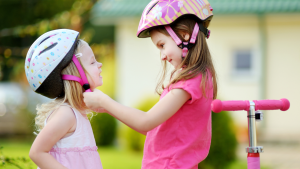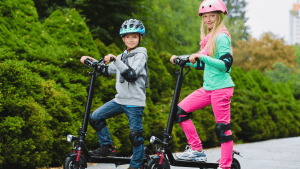We’ve all seen the joy kids experience zipping around on their scooters, but have you ever considered their pivotal role in their motor skill development?
Not only are scooters a fun and exciting form of play, but they’re also a fantastic tool to boost children’s coordination and fine motor skills. By encouraging regular scooter play, we promote physical activity and foster lifelong skills.

At FamilyHype, scootering is about having fun and learning essential values and skills. We understand that it is important to keep children safe, so we have compiled age-appropriate activities and crucial safety tips to ensure you get the most out of scootering.
We invite you to join us and explore the fun, safe, and skill-enhancing world of scooters. Please share your feedback about your experiences and opinions with us and the rest of the FamilyHype community.
Remember, scootering is not just a sport but a way of life that teaches you the importance of teamwork, balance, and perseverance.
Key Takeaways
- Scooters play a pivotal role in children’s motor skill development.
- Regular scooter play promotes physical activity and lifelong skills.
- Learning to steer a scooter while maintaining balance enhances gross motor skills.
- Scootering fosters crucial life skills and a positive attitude toward health and safety.
Understanding Motor Skills
You’ve probably heard the term ‘motor skills’ before, but let’s dive deeper to understand what they are and why they’re vital.
Motor skills are a cornerstone of physical development, enabling us to move and interact with our environment. They’re based on the neurological foundations of our bodies, meaning they are rooted in our brain and nervous system.
Various motor skill theories offer insight into how these abilities develop and function. These skills are fundamental to everyday activities, from crawling to running, picking up a spoon, or riding a scooter.
As we explore further, let’s remember to focus on safety. Ready to discover more? Let’s delve into the importance of play in nurturing motor skills development!
The Role Of Play In Motor Skill Development
It’s essential to recognize that playtime with a kick scooter isn’t just about fun; it plays a crucial role in a child’s physical development. During these playful moments, kids hone their motor skills, enhancing their coordination and balance. Playground interaction and creative movement are essential components of this development process.
Children learn how to control their bodies and navigate their environment through play. Games that involve running, jumping, or climbing can help improve balance and agility.

Playground interaction fosters social skills while also enhancing physical development. Creative movement activities, like dance or martial arts, can significantly boost motor skill development.
Incorporating props, like balls or scooters, adds an extra challenge and encourages skill advancement.
As we delve deeper into this topic, let’s focus on one such prop that’s fun and beneficial for motor skills development – the scooter.
Introduction To Scooters
Breezing through the park, kids on their two-wheeled rides effortlessly zip around, their laughter echoing as they master their balance and agility. Scooters, their preferred mode of transport, offer a fun and engaging way to enhance motor skills.
Available in many varieties, these two-wheeled contraptions cater to different age groups and skill levels, each providing a unique riding experience.
Its maintenance, crucial for safety and longevity, is a simple yet essential process teaching children responsibility. Regular check-ups for loose parts, tire pressure, and brakes ensure reliability.
How Scooters Improve Coordination
There’s an undeniable thrill that comes when your child first conquers the balance and agility needed to master their two-wheeled adventure. This joyous moment also marks a significant step in their physical development. Scooters aren’t just a source of fun and instrumental in improving coordination.
- Different Types: From three-wheelers for beginners to trick scooters for the adventurous, each type challenges and improves balance and agility.
- Steering and Balance: Learning to steer a scooter while maintaining balance enhances gross motor skills.
- Maintenance: Regular upkeep teaches responsibility and improves hand-eye coordination.
- Speed Control: Mastering the brake and learning to control speed fosters a sense of safety and precision.
After mastering these fundamental skills, your child is prepared to master the fine motor skills that scooting can help enhance.
How Scooters Enhance Fine Motor Skills
You’ll be amazed at how your little one’s precision and dexterity can flourish when zipping around on their two-wheeled ride. Scooters, regardless of their types, teach kids to use both hands in a coordinated way, enhancing their fine motor skills. They learn to balance the handlebars, master the art of steering, and maneuver the brake, all while maintaining a steady grip.

Its maintenance also comes into play here. As kids take responsibility for their scooters, they learn to handle tools, tighten screws, and adjust parts, further honing their fine motor skills.
Each ride brings a joyous smile to their faces and contributes to their motor skill development in a fun, engaging way.
How Scooters Enhance Gross Motor Skills
Believe it or not, your kiddo’s adventurous rides around the block are also a fantastic workout for their larger muscle groups. Scooting around isn’t just fun; it’s a great way to enhance gross motor skills.
When they’re steering and balancing, they’re engaging their core and legs, strengthening them over time. Scooter customization can also play a part in this. Adjusting handlebars to the right height ensures they use their arm and shoulder muscles effectively.
Regular maintenance is crucial too. It keeps the ride smooth and guarantees safety, preventing unintentional mishaps. As the child improves, we can introduce age-appropriate scootering activities to develop their motor skills while keeping the fun alive.
Which is better for your child, a balance bike or a scooter? The decision depends on your child’s age and developmental stage. Balance bikes are ideal for toddlers learning balance, while scooters are great for older kids seeking a fun and mobile way to explore.
Age-Appropriate Activities
Let’s dive into the wonderful world of scootering activities suitable for different age groups.
We’ll discuss safe activities and fun for our younger children and help them master the basics of scootering.
We’ll explore more advanced maneuvers with older children that enhance their scootering skills and keep them active and engaged.
Activities For Younger Children
Scooting around isn’t just fun for your little ones; it’s also a fantastic way to help them develop their balance, agility, and motor skills. We’ve found some simple, engaging activities to keep them active and safe.
- Maintenance basics: Teach your children how to care for their scooters, like tightening bolts and ensuring wheels are secure. This not only gives them responsibility but also enhances their fine motor skills.
- Etiquette: A great socializing opportunity. Teach them to respect others on the path, yield to pedestrians, and signal before turning.
- Races: Set up a simple course with cones. Let them practice their balance, steering, and speed control on the scooter.
Activities For Older Children
As your kids mature, they’ll need more challenging activities to keep their scootering interests piqued and their abilities advancing. We suggest introducing maintenance as a fun and educational activity. Not only will they understand their scooter’s mechanics better, but they’ll also learn to value it more, fostering a greater sense of responsibility.
Encourage them to learn advanced tricks while always emphasizing safety first. This not only sharpens their coordination but also instills confidence and resilience. Watching professional riders can be highly motivational, but reminds them that every pro started as a beginner.

Scootering is a dynamic activity that offers a range of engaging possibilities. Whether sitting, prone, or using a rope as an obstacle, children can scoot, sit, or lay on their scooters, propelling themselves forward using their feet. They can aim for targets, enhancing their accuracy and agility.
This activity builds endurance as children navigate challenges designed to test their skills. With sturdy handles providing stability and control, scooters are designed to provide a thrilling and active experience for children of all ages.
Remember, it’s all about maintaining a positive, encouraging attitude while promoting regular and safe riding.
Encouraging Regular Play
Promoting daily play on your two-wheeled vehicle isn’t just about fun; it’s also an effective strategy for bolstering a child’s motor skills. By encouraging regular play, we’re helping kids improve their balance, agility, and hand-eye coordination.
However, it’s not just about hopping on and zooming off. The type of scooter and its maintenance play a significant role too. Choosing the right type for your kid’s age and abilities is vital. There’s a perfect fit for every child, from three-wheeled ones for beginners to two-wheelers for the more advanced.
Regular maintenance ensures safe and smooth rides, further enhancing their skill development.
Next, we’ll delve into the all-important aspect of ‘safety tips for scootering,’ ensuring your little one enjoys their scooter adventures in a safe environment.
Safety Tips
Knowing your child is safe while zipping around on their two-wheelers can give you immense peace of mind. It starts with regular scooter maintenance, ensuring it is in top working condition. We must check the brake system, the handlebar’s stability, and the alignment of the wheels- small steps that can make a big difference.
Ensuring safety is paramount when it comes to scootering. One essential safety measure is highlighting the importance of wearing a properly fitting helmet, as it significantly reduces the risk of head injuries. We firmly uphold the ‘no helmet, no ride’ rule, whether you’re making your purchase in a physical walk-in store or through an online platform. Our commitment to safety remains unwavering because we believe that it should never be compromised.
By prioritizing these safety measures, we’re not just protecting our children but also instilling a sense of responsibility and awareness in them.
The Long-Term Benefits
You’ll discover that instilling these safety habits keeps your child safe and paves the path to many long-term benefits. Scootering, aside from being immensely fun, can provide a wealth of advantages for kids of all ages:
- Enhanced coordination: Regular scootering helps develop motor skills and balance, enhancing overall agility.
- Healthy lifestyle: It’s an enjoyable exercise that encourages physical activity from a young age.
- Maintenance: Learning to care for their scooter teaches responsibility and respect for their possessions.
- Confidence building: Mastering scooter skills can boost a child’s self-esteem and confidence.
- Customization: Personalizing their scooter allows for creative expression and a feeling of ownership.
These benefits extend beyond the ride, fostering crucial life skills and a positive attitude toward health and safety.
Conclusion
We’ve discovered how kid’s scooters aren’t just a fun ride but a brilliant way to boost kids’ motor skills! With regular play, they can help sharpen coordination, enhance fine motor abilities, and provide long-term benefits.
FamilyHype is here to support parents in their efforts to help their children foster motor development and agility. We recommend encouraging kids to use scooters as a fun way to learn and practice motor skills. Remember, safety first – always make sure the little ones are geared up correctly.
So, let’s get those wheels rolling and let the fun learning begin! Share your experience with FamilyHype and join the conversation by commenting below with your thoughts on scooters and motor skills.
For more ideas, check out the categories of motor skills activities on our website, including biking, running, jumping, and more. Let’s help keep our kiddos active and engaged!
Frequently Asked Questions
How Does A Scooter Help With Physical Development?
A scooter is a beneficial tool for promoting physical development in children. It helps improve motor planning, bilateral coordination, and overall body strength. Riding one requires the child to use their arms and legs simultaneously, promoting coordination and balance.
Additionally, scooting requires the child to engage their core muscles to maintain stability and balance while maneuvering. This strengthens their core and improves their posture. Furthermore, scooting encourages outdoor play and exploration, providing opportunities for cardiovascular exercise and enhancing overall physical fitness.
What Is A Scooter Board Good For?
A scooter board is a versatile piece of equipment that offers various benefits. It can be used for board activities, such as an obstacle course, where children can practice motor planning and coordination while navigating challenges. It also helps develop core strength, endurance, and spatial awareness.
Scooter boards can also be used for social skills, as they encourage girls and boys to cooperate and communicate with each other. They can help children learn to share, take turns, and follow the rules, while also fostering the development of empathy and perspective-taking skills
What Are The Benefits Of Scooters In PE?
Scooters are excellent for physical education (PE) classes as they provide a fun and engaging way to improve children’s gross motor skills. Scooter fun activities like racing or playing scooter hockey promote cardiovascular endurance and teamwork.
What Age Are Scooter Boards For?
Scooter boards are suitable for children of various ages, typically preschoolers to early elementary school-age children. However, it’s essential to consider individual abilities and safety guidelines when determining if a child is ready to use one.
Is Scootering Good For Kids?
Yes, scootering is beneficial for kids. It helps enhance their balance and coordination, as well as their overall physical fitness. Additionally, it can boost children’s confidence, independence, and outdoor exploration.
A scooter for kids also helps develop their confidence and self-esteem. It allows them to explore their abilities and challenge themselves. It also helps them overcome their fears and frustrations and celebrate their achievements. It is worth mentioning that the scooter must be appropriate for the kids’ ages.
What Is The Best Age To Learn A Scooter?
The best age to introduce a child to scootering depends on their development. Most children can start learning to ride one around three or four when they have developed better balance and agility. However, it’s essential to consider their motor skills and follow any recommended age guidelines the manufacturer provides.
The best time to advance the child’s skills is when they show interest and readiness. Some children may want to try different types of scooters, such as three-wheeled or electric ones. Others may want to learn new tricks or stunts like jumping or spinning. Supporting the child’s learning and creativity is essential while ensuring their safety and enjoyment.
How Do I Choose A Scooter For My Child?
When selecting a scooter for your child, consider their age, size, and skill level. Look for ones designed for their age group, with adjustable handles, sturdy construction, and appropriate safety features. Ensure it is easy to maneuver and provides a comfortable riding experience.
You may also want to consider the ride-on toy’s type and number of wheels. Some ride-on toys have two wheels, which offer more speed and agility but require more balance and coordination. Others have three or four wheels, which provide more stability and support but are less flexible and responsive.
Are Scooters Easy To Learn?
Scooters are generally easy to learn, especially for children who have developed basic balance and coordination skills. Most kids grasp the concept of riding one within a short period. However, it’s essential to supervise them during the initial learning phase and ensure they wear appropriate safety gear.
They are also easy to learn because they are adaptable and versatile. Children can ride them on various terrains and surfaces, such as pavement, grass, or dirt. They can also choose from different types and styles of this ride-on, such as two-wheeled, three-wheeled, or electric ones.
Can A 2-Year-Old Have A Scooter?
While a 2-year-old may be too young to ride a traditional scooter, there are specially designed ones for toddlers. They typically have three or four wheels, provide better stability, and are closer to the ground, making them safer for younger children. Always supervise your child closely when using one, regardless of age.
A ride-on toy can be a great way to introduce your 2-year-old to physical activity and movement. It can help them develop their gross motor skills, such as balance, coordination, and strength. It can also stimulate their senses, like vision, hearing, and touch.
How Do I Choose A Scooter For My 2-Year-Old?
When selecting a scooter for a 2-year-old, opt for models with a stable and low-to-the-ground design. Look for ones with wide bases, sturdy construction, and easy-to-grip handles. Ensure it has safety features such as a non-slip deck and a secure steering mechanism. Additionally, choose one with an adjustable handlebar to accommodate your child’s growth.
You may also want to consider the weight and size of this ride-on. Choose one that is lightweight and easy to maneuver for your child. Avoid too heavy or bulky ones, as they may cause difficulty or injury.
DISCLAIMER (IMPORTANT): This information (including all text, images, audio, or other formats on FamilyHype.com) is not intended to be a substitute for informed professional advice, diagnosis, endorsement or treatment. You should not take any action or avoid taking action without consulting a qualified professional. Always seek the advice of your physician or other qualified health provider with any questions about medical conditions. Do not disregard professional medical advice or delay seeking advice or treatment because of something you have read here a FamilyHype.com.